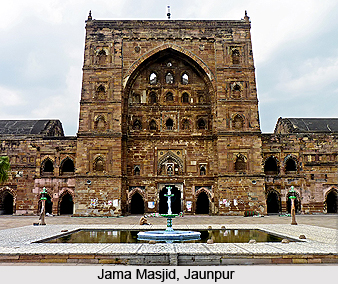 Jama Masjid, situated in Jaunpur district of Uttar Pradesh, forms a prime religious as well as tourist site of the state. This ancient mosque is also known as Jami Masjid, Jama Mosque and Bari Masjid. The foundation stone of the mosque was laid during the reign of Ibrahim Shah and its completion covered several phases. It was finally finished in 1470 by the last monarch of Sharqi dynasty called Hussain Shah. Historians have stated that the mosque exhibits stark resemblance with the mosques constructed during the rule of Firoz Shah Tughlaq of the Tughluq dynasty. The mosque is the manifestation of magnificent architecture and artistry. On every Friday, special prayers are conducted in the mosque.
Jama Masjid, situated in Jaunpur district of Uttar Pradesh, forms a prime religious as well as tourist site of the state. This ancient mosque is also known as Jami Masjid, Jama Mosque and Bari Masjid. The foundation stone of the mosque was laid during the reign of Ibrahim Shah and its completion covered several phases. It was finally finished in 1470 by the last monarch of Sharqi dynasty called Hussain Shah. Historians have stated that the mosque exhibits stark resemblance with the mosques constructed during the rule of Firoz Shah Tughlaq of the Tughluq dynasty. The mosque is the manifestation of magnificent architecture and artistry. On every Friday, special prayers are conducted in the mosque.
Architecture of Jama Masjid
Jama Masjid of Jaunpur has a number of enchanting features which highlights its beauty. The entire building stands on a six metres high plinth. The mosque premise has gateways at four cardinal points out of which the eastern one was destroyed by Sikandar Lodi. At the main entrance, there is an elegant double-arched gate having a pylon shape. Twenty seven long steps lead to the beautiful gate of the mosque. The mosque houses a colossal rectangular hall where prayers are conducted. It is covered by a dome having a diameter of 11.4 meters and tunnel vaults flanks the sides of the hall. Small windows are present in the dome through which the sunlight enters the interior of the mosque and creates a spectacular sight. Jama Masjid of Jaunpur is marvellously embellished and its decorations can be mostly found in the interior and exterior walls of the mosque. Engravings and decorations of Egyptian style can also be witnessed which comprise rose and sunflower motifs, unique lotus patterns and elegant curves of arches. These adornments render it a distinct place among the sacred places of Jaunpur. The style of beam and bracket construction is also unique.
Visiting Information
Jama Masjid can be reached by bus through National Highway NH-56 which connects Jaunpur to other parts of the country. It can also be reached through railways as Jaunpur station is connected with all the major Indian cities. The three major railway stations of Jaunpur are Shahganj Junction (SHG), Jaunpur Junction (JNU) and Jaunpur City Station (JOP). Varanasi Airport or Lal Bahadur Shastri International Airport is the nearest airport to Jaunpur.





















